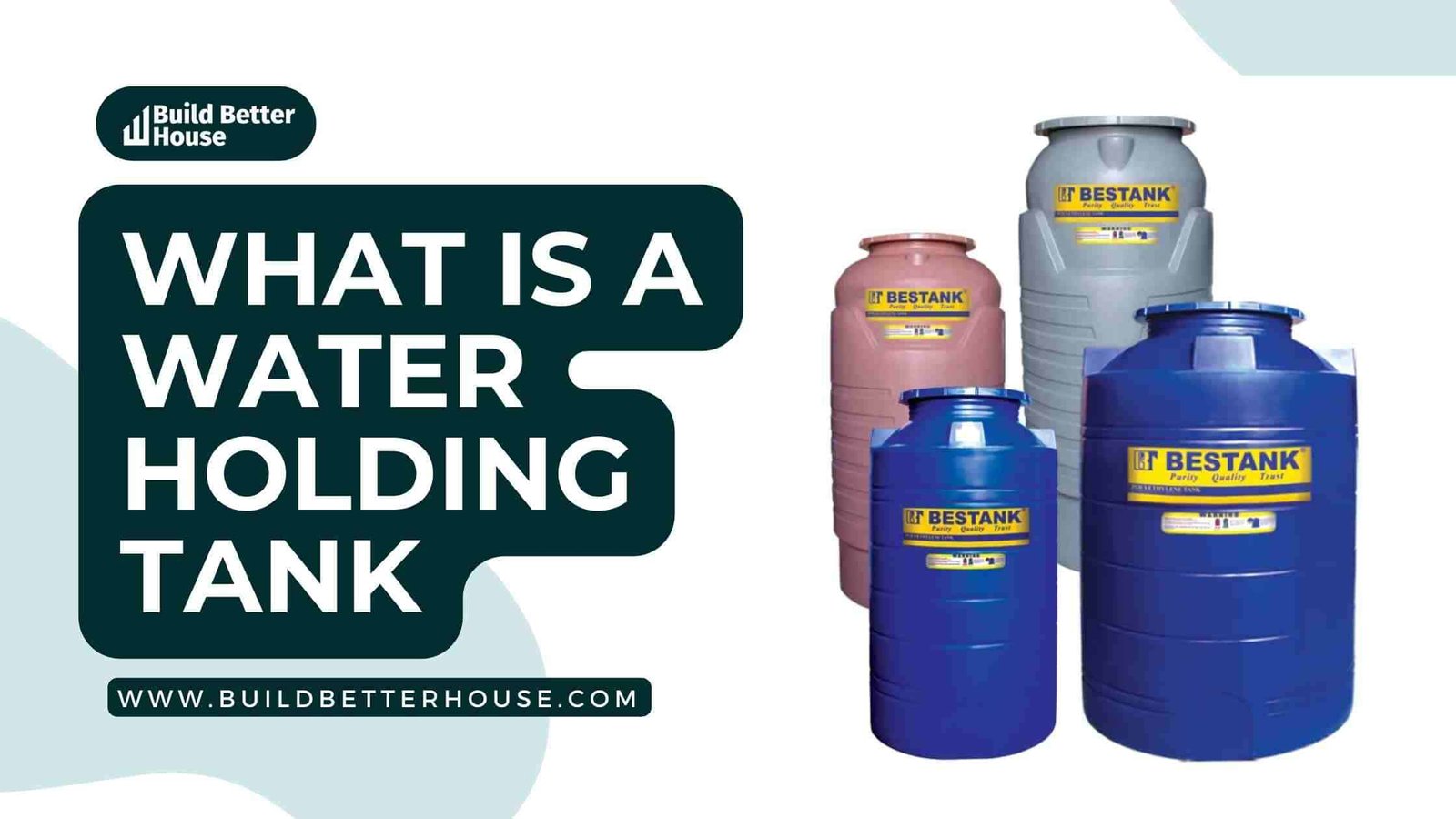Water Holding Tank: Find Out If You Need One

Suppose you require additional storage for pure water after it passes through a reverse osmosis system or another water filter. In that case, we suggest installing a water holding tank for well water or other pure water.
A reverse osmosis system or other filtration systems store clean water in a water storage tank until you need it. There are many types, styles, and specifications of water holding tanks, and you may use them for residential, commercial, or large-scale industrial or municipal purposes.
In this post, we’ll discuss everything you need to know about water holding tanks, including how they operate, how to pick the proper size and the 5 benefits of installing a holding water system in your home.
What Is A Water Holding Tank?
Water storage tanks keep water for later use and instant access. When you turn on your tap, water is delivered from the tank to your faucet, allowing you to obtain fresh water on demand.
Reverse osmosis systems operate slowly, purifying water drop by drop. Since it works gradually, you can access this reverse osmosis water holding tank whenever you want without waiting for it to fill your glass.
There are a variety of tank designs and sizes to match your water treatment needs. Small, 5-gallon reverse osmosis tanks under your sink are just one example of the many water storage tanks available.
Water holding tanks are an essential component of many household water systems. These tanks usually store large quantities of rainwater, healthy water, or firefighting water.
Large outdoor atmospheric tanks can store thousands of gallons of water. UV inhibitors prevent algae and bacteria from growing in these tanks due to sunlight.
How Does A Water Holding Tank Work?
The storage tank stores clean water from your reverse osmosis system whenever your house or business requires water. Water is pumped into the tank from your water sources, such as a well or a reverse osmosis system.
The tank accumulates water until it is complete. When you need water for drinking, bathing, or irrigating a field, you get it instantly from the storage tank.
Pressure and atmospheric tanks are the two most common water holding tanks. Reverse osmosis storage tanks are used primarily on point-of-use applications.
Why Should You Install A Water Holding Tank?
Are you still trying to decide whether to install a water holding tank in your home? Here are the top five reasons a pressurized water system in the basement is the best choice.
Constant Fresh Water
It’s unfortunate to run out of clean water when washing the plates or taking a shower. With a 5000+ gallon reservoir, the basin will likely run dry after your water holding tank refills it.
No Low Water Pressure
It’s just as bad as running out of water if you have low water pressure. A large water tank and pressure pump can supply enough pressure to mimic city water straight from the water supply.
More Effective
An additional advantage of water holding tanks is that they are more efficient at delivering clean water (free of sediment) on demand.
Water filtration systems may take a moment to activate, and if you have two or more faucets open at the same time, a jet pump might need to be able to provide enough water.
Fire Prevention
Having a big water holding tank for well water is essential for firefighting. A fire can ruin your home, and with a 10,000-gallon tank, you can prevent the fire from spreading until the local fire department arrives.
You’ll depend on the flow from city pipes and water wells unless you have a sizable on-demand water supply and submersible pump.
Never Run Out of Drinking Water
Keeping a freshwater supply for drinking in an emergency is more important than ever. You can maintain yourself for a long time with a 10,000-gallon tank of fresh water in your basement.
What Size Of Water Holding Tank Do You Need?
The size of the water storage system you require depends on various factors, particularly the number of people in your household and the amount of space you need.
You’ll need a more extensive water holding tank if you have a lot of square footage or a large family. The more your household demands, the more water storage you’ll require.
To maintain a constant flow rate, reverse osmosis and filter systems refill the water storage tank over time. You must have enough fresh water to keep your desired flow rate, so you must consider the size of your water tank in terms of storage areas.
Water storage takes up a lot of space, so you must have a lot of free space in your basement or somewhere near your home to bury the potable water supply.
According to tank manufacturers, you can determine how big your tank should be by multiplying the number of water-using fixtures by three.
For example, if you have two showers, three toilets, five taps, one dishwasher, one clothes washer, and one fridge, you’ll have thirteen water-using appliances.
A 39-gallon tank would provide enough water for this household if we multiply 13 by three. A tank that’s the right size will keep the pump operating longer by protecting it from being turned on and off too frequently.
How To Calculate Water Holding Tank Capacity?
When buying a water holding tank, you should know that the stated gallon capacity on the label may differ from the tank’s actual capacity. A pressure or reverse osmosis tank includes a diaphragm and an air bladder.
A 32-gallon tank, for instance, has a total void volume of 32 gallons if the diaphragm and air bladder are removed. A tank’s capacity is the amount of water it can hold, not its advertised gallon capacity.
Choosing the water holding tank capacity that is most suitable for your home, office, or restaurant is essential. The water holding tanks are consistently sized according to demand.
Suppose you are a coffee shop using an RO tank to provide water to several espresso machines and ice makers. In that case, your tank capacity will significantly differ from a family of two using an RO tank at home.
You will know if you have chosen the proper tank size if it provides daily water with no interruptions or reduced pressure.
How To Install A Water Holding Tank?
Installing a water storage tank is a manageable task. The installation process of a tank requires several components to ensure that the system runs smoothly. Here are the steps to install a water holding tank:
1. Connect the Tank to the Filtration System
You must hook the water tank to the filtration system to continuously supply clean water. These two systems must be close to one another so that you don’t have to install a lot of piping to transport the water.
2. Install the Check Valve and Pressure Gauge
It’s essential to monitor water tank levels and pressures, to ensure they remain at the desired level. You can quickly evaluate your system’s operation by installing the check valve and pressure gauge.
3. Start the Filter System
When you turn on the filter system, make sure that water is pouring into the tank. Filtering systems operate slowly, so filling a large tank with water will take at least 24 hours.
4. Adjust the Flow Rate
Once the tank is full of water, open the shower head or faucet and test the pressure. The flow rate must be adjusted so that the correct quantity of water enters the pipes.
If the pressure is too high, a leak may occur, and if it is too low, water will not flow adequately out of the faucet.
5. Add Chlorine, Fluoride, or other Minerals
Most regions of the United States add Fluoride to the water. Still, if you live in a remote location, you should add Chlorine, Fluoride, or other Minerals to preserve the water over a long period.
How To Clean A Water Holding Tank?
All water holding tanks must be cleaned and maintained to keep your water clean and pure. Regular cleaning will flush out debris from the storage tank and remove any bacteria, algae, or accumulated slime that may have grown in it.
It will help if you clean reverse osmosis storage tanks annually to eliminate dirt. As a result, many reverse osmosis system owners opt to combine filter replacements with cleaning cycles.
If you have a reverse osmosis storage tank, you may use a sanitization kit such as Sani-System. It is free of chlorine and NSF-certified to eradicate e.coli and other harmful bacteria.
To maintain your reverse osmosis system and ensure that bacteria do not spread throughout it, add chlorine drops from time to time. If you own an atmospheric storage tank, periodically add chlorine to disinfect the water and eliminate bacterial growth.
Over time, sediment from your well water will accumulate in your tank. Placing a sediment filter between the pressure switch and the pump is usually discouraged, as it can interfere with the pump’s on/off cycles.
Your household water pressure may decrease with enough sediment in your pressure tank. To eliminate any buildup, you must periodically flush your system.
Wrapping Up
A water holding tank stores clean water from your reverse osmosis system or other filtration methods until you’re ready to use it.
Water holding tanks are used in various fields, including household water storage, commercial food and beverage preparation, agricultural and irrigation work, fire extinguishing, and industrial manufacturing.
The tank’s dimensions and specifications will depend on the job and the daily water consumption of the home or business.






